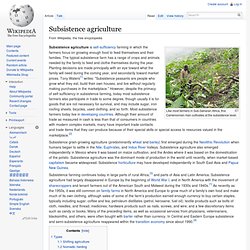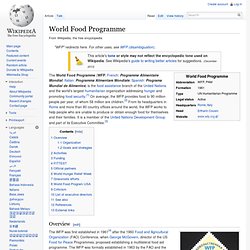

Food fight warning. National-food-plan-green-paper-072012.pdf (application/pdf Object) Tragedy of the Commons - water, human, use. Subsistence agriculture. Like most farmers in Sub-Saharan Africa, this Cameroonian man cultivates at the subsistence level.

Subsistence agriculture is self-sufficiency farming in which the farmers focus on growing enough food to feed themselves and their families. The typical subsistence farm has a range of crops and animals needed by the family to feed and clothe themselves during the year. Planting decisions are made principally with an eye toward what the family will need during the coming year, and secondarily toward market prices. Tony Waters[1] writes: "Subsistence peasants are people who grow what they eat, build their own houses, and live without regularly making purchases in the marketplace. " However, despite the primacy of self-sufficiency in subsistence farming, today most subsistence farmers also participate in trade to some degree, though usually it is for goods that are not necessary for survival, and may include sugar, iron roofing sheets, bicycles, used clothing, and so forth.
Types[edit] World Food Programme. The World Food Programme (WFP; French: Programme Alimentaire Mondial; Italian: Programma Alimentare Mondiale; Spanish: Programa Mundial de Alimentos) is the food assistance branch of the United Nations and the world's largest humanitarian organization addressing hunger and promoting food security.[1] On average, the WFP provides food to 90 million people per year, of whom 58 million are children.[2] From its headquarters in Rome and more than 80 country offices around the world, the WFP works to help people who are unable to produce or obtain enough food for themselves and their families.

It is a member of the United Nations Development Group and part of its Executive Committee.[3] Overview[edit] The WFP was first established in 1961[4] after the 1960 Food and Agricultural Organization (FAO) Conference, when George McGovern, director of the US Food for Peace Programmes, proposed establishing a multilateral food aid programme.
Organization[edit] Goals and strategies[edit] Activities[edit] World Summit on Food Security: World Summit. World Food Summit. WORLD FOOD SUMMIT: Five Years Later. United Nations World Food Programme - Fighting Hunger Worldwide. The surge in land deals: When others are grabbing their land. Our article on Bangladesh and India: The government of Bangladesh responds. Vegetable oil: What’s cooking? OIL markets are full of uncertainty.

Asian demand is booming and doubts abound over the ability of supply to match the world's appetite. What goes for crude oil also applies to the stuff squeezed out of vegetable matter. The price of stir-frying and dressing a salad has rarely been higher. Over the past decade the price of vegetable oils has all but quadrupled. Like other commodities, prices hit records in 2008. Kona Haque of Macquarie, an Australian bank, points to two structural factors behind oil's sizzle: China and biodiesels. In the past few years a new source of demand has emerged for vegetable oils. The effect of growing demand for the two main types of vegetable oil, palm and soya (see chart), is amplified by supply problems. Palm oil, also used to make soaps and cosmetics, comes almost exclusively from Indonesia and Malaysia. Finding more land has unpalatable costs.
Adapting to climate change: Facing the consequences.